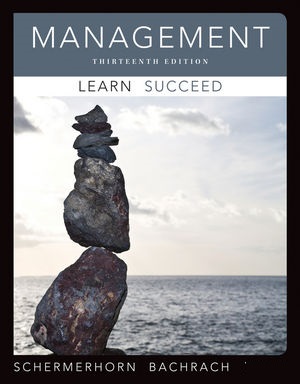
Management 13th Edition by John Schermerhorn,Daniel Bachrach
Edition 13ISBN: 978-1118841518
Management 13th Edition by John Schermerhorn,Daniel Bachrach
Edition 13ISBN: 978-1118841518 Exercise 14
LEARN FROM ROLE MODELS
The nonprofit's mission is combining "rigorous research with innovative solutions to improve the health and quality of life of young people with chronic illness."
Video Game Motivates High-Risk Kids to Take Medicines

A lthough many of us play video games just for fun, teens with cancer can now play games that can help them to beat the disease. Picture a teenager who has a tough time keeping up with cancer medication schedules. Now imagine him playing the video game called Re-Mission and maneuvering a nanobot called Roxxi through the body of a cancer patient to destroy cancer cells. Then think about an article in the medical journal Pediatrics that reports teen patients who play the game at least one hour a week do a better job of sticking to their medication schedules.
What's taking place is the brainchild of HopeLab, founded by Pam Omidyar. An immunology researcher and gaming enthusiast, Omidyar saw the possible link between games and fighting disease. The nonprofit's mission is combining "rigorous research with innovative solutions to improve the health and quality of life of young people with chronic illness."
One of HopeLab's products is Zamzee, described as a "gamebased website." It includes an activity meter where kids earn points for movement and activity. A recent research study looking at possible benefits concluded that "kids using Zamzee increased their moderate-to-vigorous physical activity (MVPA) by an average of 59%-or approximately 45 additional minutes of MVPA per week."
FIND THE INSPIRATION
Re-Mission is one positive step in the war against childhood cancer. One of HopeLab's current priorities is to use video gaming in the fight against childhood obesity. Think about how creative approaches to motivation might be used to improve peoples' lives in other ways as well.
The nonprofit's mission is combining "rigorous research with innovative solutions to improve the health and quality of life of young people with chronic illness."
Video Game Motivates High-Risk Kids to Take Medicines

A lthough many of us play video games just for fun, teens with cancer can now play games that can help them to beat the disease. Picture a teenager who has a tough time keeping up with cancer medication schedules. Now imagine him playing the video game called Re-Mission and maneuvering a nanobot called Roxxi through the body of a cancer patient to destroy cancer cells. Then think about an article in the medical journal Pediatrics that reports teen patients who play the game at least one hour a week do a better job of sticking to their medication schedules.
What's taking place is the brainchild of HopeLab, founded by Pam Omidyar. An immunology researcher and gaming enthusiast, Omidyar saw the possible link between games and fighting disease. The nonprofit's mission is combining "rigorous research with innovative solutions to improve the health and quality of life of young people with chronic illness."
One of HopeLab's products is Zamzee, described as a "gamebased website." It includes an activity meter where kids earn points for movement and activity. A recent research study looking at possible benefits concluded that "kids using Zamzee increased their moderate-to-vigorous physical activity (MVPA) by an average of 59%-or approximately 45 additional minutes of MVPA per week."
FIND THE INSPIRATION
Re-Mission is one positive step in the war against childhood cancer. One of HopeLab's current priorities is to use video gaming in the fight against childhood obesity. Think about how creative approaches to motivation might be used to improve peoples' lives in other ways as well.
Explanation
In the present case there is a company t...
Management 13th Edition by John Schermerhorn,Daniel Bachrach
Why don’t you like this exercise?
Other Minimum 8 character and maximum 255 character
Character 255


